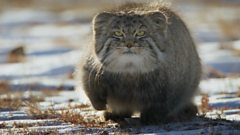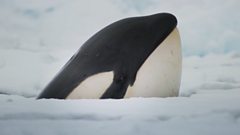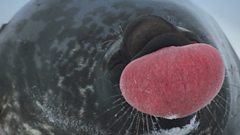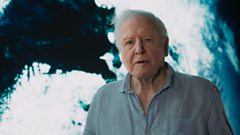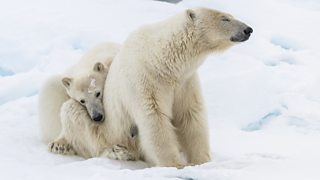Frozen Worlds
From the poles to the highest mountain peaks, there are surprising frozen worlds found on every continent, and each is home to unique and remarkable animals.
Journeying from pole to pole, we reveal the surprising frozen worlds that exist across the planet and the remarkable animals that make them their home.
We begin our journey in the far south, in the most hostile place on earth, the frozen continent of Antarctica. After being raised on the ice in winter, emperor penguin chicks find themselves abandoned by their parents in spring. To survive, they must find their own way across the treacherous sea ice to the rich waters of the Southern Ocean.
The waters surrounding Antarctica may be the richest of all, but they are also home to an exceptionally sophisticated predator, the killer whale. To reach their favoured prey, Weddell seals, a family of killer whales have learnt to generate their own waves, washing the seals off their ice floes. It鈥檚 a technique that has been passed down over generations and is coordinated by the family matriarch, who can be over 100 years old.
Leaving Antarctica and travelling north, we discover frozen habitats that are created by altitude. The greatest of these is the Himalaya, the tallest mountain range on earth, which contains so much ice and snow it is known as the third pole. In the shadow of the Himalaya lies a vast frozen grassy plain that is home to the fluffiest cat in the world, Pallas鈥檚 cat. It may have extremely dense fur, but if it鈥檚 to survive the Mongolian winter, it needs to catch lots of gerbils and voles. Easier said than done when you only have short legs and paws that are sensitive to the cold.
North of the Great Steppe lies the boreal forest, which encircles the continents of North America, Europe and Asia, and remains frozen for six months of the year. Prowling these forests in the far east of Russia is the Siberian tiger, the largest cat in the world. In winter, it is on the lookout for black bears hibernating in caves, a high-risk strategy that only a cat of this size would attempt.
Above the boreal forest, we cross into the Arctic Circle, where conditions become so extreme that trees can no longer grow. This is the tundra. Living here are relics of the last ice age, musk ox. In spring, their calves face a far greater danger than the cold, grizzly bears. Encounters can be brutal, but if just a few calves survive the gauntlet, the herd鈥檚 future is secure.
To the north of the tundra is the Arctic Ocean, the only ocean that can completely freeze over. Living here is one of the most peculiar animals on earth, the hooded seal. Males have extraordinary inflatable noses, producing a bright red balloon out of their left nostrils. One male hopes this will make him irresistible.
All of the frozen habitats share one thing in common: the threat posed by today鈥檚 climate change. Travelling to the island of Greenland, home to the largest body of ice in the northern hemisphere, we witness how global warming is melting its ice cap at faster rates than ever before, with profound consequences for global sea levels. Lastly, we visit the Arctic鈥檚 most iconic resident, the polar bear, as a mother bear struggles to provide for her cubs in a world of shrinking sea ice.
Last on
More episodes
Previous
You are at the first episode
Clips
-
![]()
"The grumpiest cat in the world"
Duration: 02:54
-
![]()
Killer whales hunt a seal on the pack ice
Duration: 03:20
-
![]()
The inflatable nose of the hooded seal
Duration: 03:32
-
![]()
Sir David Attenborough introduces Frozen Planet II
Duration: 02:34
Credits
| Role | Contributor |
|---|---|
| Presenter | David Attenborough |
| Producer | Alex Lanchester |
| Series Producer | Elizabeth White |
| Executive Producer | Mark Brownlow |
Broadcasts
Featured in...
![]()
iPlayer Unwrapped 2022
Unmissable TV moments from last year
![]()
iPlayer Unwrapped 2022
Unmissable TV moments from last year
![]()
Ultra HD on 成人快手 iPlayer
Enjoy a cinematic experience at home with top titles available in ultra-high definition.
![]()
New and Trending
Latest releases on iPlayer
![]()
Secrets of the Seas
Discover the abundance of life underneath the surface.
![]()
Earth Day
Facts about the environment and the challenges facing our planet to mark Earth Day.
![]()
Our Planet Now
Facts about the environment and the challenges facing our planet.
![]()
You and Your World
Explore and learn about the world around you ...
![]()
Family Favourites
Must watch shows from across the 成人快手
![]()
Our Planet Now
It's Recyle Week! Learn about our environment and how to look after it ...
![]()
Sir David Attenborough
Sir David Attenborough's amazing programmes from the 1950s to the present day.
![]()
Sir David Attenborough
His incredible programmes and his amazing career - all in one place
![]()
Wonderful Wildlife
Explore the world around you with natrual history from across the 成人快手 ...
![]()
Family Favourites
All your favourites from across the 成人快手
![]()
Critically Acclaimed Documentaries
Timeless moments, revealing stories, honest accounts.
![]()
2022 Highlights
The most watched documentaries in 2022.
![]()
Science & Nature
Discovering the 成人快手 's Signed Science & Natures programmes
![]()
iPlayer 13-15 成人快手page :: Documentaries
iPlayer 13-15 成人快手page - Documentaries

